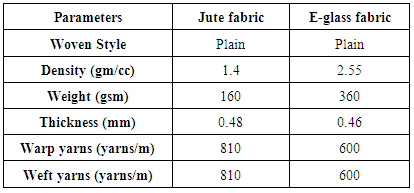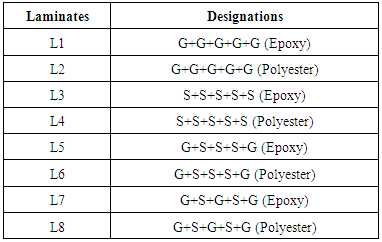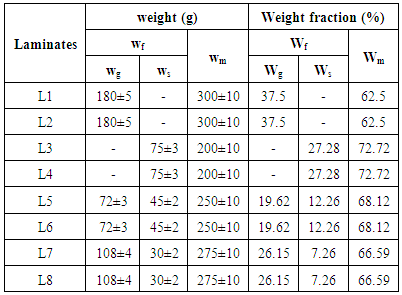-
Paper Information
- Paper Submission
-
Journal Information
- About This Journal
- Editorial Board
- Current Issue
- Archive
- Author Guidelines
- Contact Us
International Journal of Composite Materials
p-ISSN: 2166-479X e-ISSN: 2166-4919
2017; 7(3): 77-81
doi:10.5923/j.cmaterials.20170703.01

Tensile Property Evaluation of Sisal – Glass Fiber Reinforced Polymer Based Composites
L. Laxmana Naik1, 2, Kavya H. M.3, K. Gopalakrishna2, 4, B. Yogesha1
1Department of Mechanical Engineering, Malnad College of Engineering, Hassan, India
2Jain University, Bangalore, Karnataka, India
3Department of Mechanical Engineering, B.N.M. Institute of Technology Bangalore, India
4Centre for Incubation, Innovation, Research and Consultancy (CIIRC), Jyothy Institute of Technology, Bangalore, India
Correspondence to: B. Yogesha, Department of Mechanical Engineering, Malnad College of Engineering, Hassan, India.
| Email: |  |
Copyright © 2017 Scientific & Academic Publishing. All Rights Reserved.
This work is licensed under the Creative Commons Attribution International License (CC BY).
http://creativecommons.org/licenses/by/4.0/

The present work is undertaken to study the tensile property of sisal - glass fiber reinforced polymer based hybrid composites fabricated by vacuum bagging method. Each laminate consists of five plies of fabrics and resin mixture with 3 mm thickness as per different layering designation. The Specimen preparation and tensile test was carried out as per ASTM standards. It was observed that, tensile strength of the glass and sisal-glass fiber hybrid composites were higher than those of composites reinforced with sisal only, due to hybridization.
Keywords: Sisal fiber, Glass fiber, Vacuum bag, Epoxy, Polyester
Cite this paper: L. Laxmana Naik, Kavya H. M., K. Gopalakrishna, B. Yogesha, Tensile Property Evaluation of Sisal – Glass Fiber Reinforced Polymer Based Composites, International Journal of Composite Materials, Vol. 7 No. 3, 2017, pp. 77-81. doi: 10.5923/j.cmaterials.20170703.01.
Article Outline
1. Introduction
- The global interest in natural fiber composites has been growing in the last decade because there is a realization that alternatives have to be found for man-made fibers such as carbon and glass fibers. Natural fibers are also light compared to glass, carbon and aramid fibers. Together with their desirable mechanical properties, they are becoming increasingly useful as raw materials for the preparation of cost-effective and environmentally friendly composite materials [1-6]. The natural fiber composites form one of the emergent areas in material science that makes awareness for use in various applications [7]. The composites obtained by incorporation of two or more fibers within a single matrix are called as hybrid or hybrid composites. Hybrid fiber composites may be the combination of two or more different natural fibers or it may be the combination of natural or synthetic fibers. The conventional material such as glass, carbon and boron fibers are quite expensive and the use of fiber like carbon or boron is justified only in aerospace application. Therefore it is meaningful to explore the possibility of using cheaper materials such as natural fiber as reinforcement. Various aspects of hybrid fiber based polymer composites has studied by various investigators. Jawaid et al. [8] studied the mechanical behaviour of hybrid composites based on jute and oil palm fiber. It has been found that the use of hybrid system was effective in increasing the tensile and dynamic mechanical properties of the oil palm-epoxy composite because of enhanced fiber/matrix interface bonding. Sanjay et al. [9] performed on immersing specimens into three different water conditions, namely normal, distilled and salt water. Specimen preparation and water absorption studies carried out as per ASTM standards. It indicates that the hybridization of E-glass with jute and kenaf decreases the maximum water absorption. Verma et al. [10] examined the mechanical properties of glass/jute hybrid composites. The jute fabrics were modified by treatment with different chemicals. It has been observed that titanate treatment of jute fabric results in enhanced performance characteristics and mechanical properties of hybrid composites. Ahmed et al. [11] investigated the elastic properties and notch sensitivity of untreated woven jute and jute-glass fabric reinforced polyester hybrid composites, analytically and experimentally. The jute composites exhibited higher notch sensitivity than jute–glass hybrid composites. Arpitha et al. [12] prepared sisal/glass/Sic fiber reinforced epoxy composites and evaluated their mechanical properties such as tensile strength, flexural strength and impact strength. Composites of silicon carbide filler (without filler, 3, 6 & 9Wt %) sisal fiber and glass fiber were investigated and results showed that the composites without filler better results compared to the composites with silicon carbide filler. Dixit et al. [13] reported a remarkable improvement in the tensile and flexural properties of hybrid composites compared to the un-hybrid composites. It was also found that the hybrid composite offers better water absorption resistance. Sanjay and Yogesha [14] determined the hybrid effect of composites made of jute/E-Glass fibers which were fabricated by hand layup method using LY556 Epoxy resin and HY951 hardener. It was found that the hybrid composite has better strength as compared to jute fiber composite fabricated separately with glass fiber. Ahmed et al. [15] experimentally investigated the effect of stacking sequence on mechanical properties of woven jute and glass fabric reinforced polyester hybrid composites. The layering sequence has larger effect on the flexural and inter-laminar shear properties than tensile properties. On comparing the overall properties of the laminates it was concluded that the hybrid laminates with two extreme glass plies on both side has the optimum combination with a good balance between the properties and the cost. Thew and Liao [16] informed that mechanical properties of bamboo/glass fiber reinforced hybrid composites depends on fiber length, fiber weight ratio and adhesion characteristics between the matrix and the fiber. Pandya et al. [17] found that on placing glass fabric layers in the exterior and carbon fabric layers in the interior of the hybrid composites gives higher tensile strength and ultimate tensile strain than hybrid composites with carbon fabric layers in the exterior and glass fabric layers in the interior. Sreekala et al. [18] concluded that incorporation of small volume fraction of glass fiber in composites results in enhanced tensile and flexural properties. Velmurugan et al [19] studied the tensile, shear, impact and flexural properties of the palmyra/glass fiber hybrid composites. The properties of the hybrid were found to be increasing continuously with the addition of glass fiber. Goud and Rao [20] found a considerable increase in the tensile, flexural, impact and hardness properties of Roystonearegia/glass fiber hybrid composites with the increase in glass fiber loading. Pothan et al. [21] studied on the banana-glass hybrid composites and found layering pattern or the geometry of the composites has a profound effect on the dynamic behaviour of the composites.
2. Materials and Methods
2.1. Materials Used
|
2.2. Fabrication Method
- The composite laminate consists of number of layers in which glass fiber layers and sisal fiber layers are placed alternatively until we obtain required thickness. A mat with large surface area is been placed on a floor, and wax is applied on its surface to avoid the adherence of laminate to the mat. Then a layer of matrix is applied over the wax in a particular direction. Later alternative layers of hemp and glass fabrics are placed with the application of matrix in between. This is called ‘Hand Lay-Up Method’. Perforated sheets are placed over laminates and resin absorber sheets are placed over perforated sheets and whole laminates, perforated sheets and resin absorber sheets are covered by vacuum bag and sealed. Then vacuum pressure is maintained inside vacuum bag and the laminates are cured at that pressure for four hours. The method followed above is called vacuum bagging method as shown in Fig.1. Later the laminates are cured under normal atmospheric pressure and temperature for 12 hrs. For the better curing, the laminates are cured in ‘Autoclave Machine’ at 60 degree for four hrs is presented in Fig. 2 [22, 23].
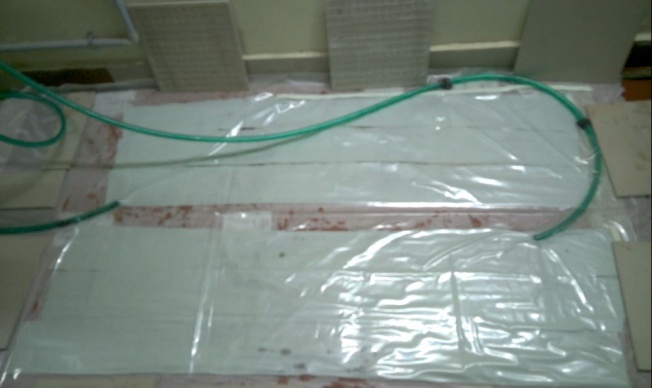 | Figure 1. Vacuum Bagging Method |
 | Figure 2. Autoclave Machine |
 | (1) |
|
|
2.3. Tensile Test
- The tensile strength of the composites is measured using a 100 KN Kalpak computerized Universal testing machine of model KIC-2-1000-C in accordance with the ASTM D638 (115x19x3 mm3) standards at a cross head speed of 10 mm/min. Figure 3 shows Tensile test specimens of L1 type before test and after test.The ultimate tensile strength (UTS) and tensile modulus of composite specimen was determined using the Eqs. (2) & (3) respectively:
 | (2) |
 | (3) |
 | Figure 3. Tensile test specimens of L1 type before and after test |
3. Results and Discussion
- The variation of the tensile strength and modulus of sisal-glass reinforced hybrid polymer composites is shown in Table 4. It is clearly observed that both the tensile strength and modulus are improving with increase in glass fiber weight ratio. This decline in strength may be attributed to two reasons: one possibility is that the due to the presence of pores at the interface between the fibers and the matrix, the interfacial adhesion may be too weak to transfer the tensile stress; the other is that the corner points of the irregular shaped fibers result in stress concentration in the matrix body. Figure 5 shows the tensile load vs displacement curve of the composite laminates. The stress vs. strain curve of composite laminates are presented in Figure 6. The stress-strain curves of each composites highlight the brittle behavior of these materials, characterized by a hardening final part, also in the case of tensile tests. On the other hand, stress-strain curves for all type of material used, are characterized happens in the case of non-impregnated fabrics. The laminate L2 yields better tensile load of around 6000 N compared to other laminates. The tensile strength of laminate L1 and L2 made of pure E-glass are 298 MPa and 332 MPa, and modulus of 12.584 GPa and 12.861 GPa which is greater than the other laminates. The tensile strength of laminate L7 and L8 made of sisal and E-glass are 130 MPa and 148 MPa, and modulus of 6.8 GPa and 6.9 GPa which is shows better results than the natural fiber laminates.
|
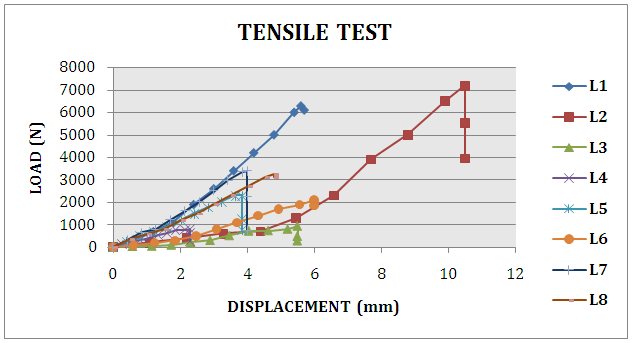 | Figure 5. Tensile load vs displacement curve of the composite laminates |
 | Figure 6. The stress vs. strain curve of composite laminates |
4. Conclusions
- A multilayered hybrid composite has been fabricated successfully by reinforcing low cost, light weight, eco-friendly sisal fibres with glass fiber, using an epoxy and polyester resin matrix. The tensile strength of laminate L1 and L2 made of pure E-glass are 298 MPa and 332 MPa, and modulus of 12.584 GPa and 12.861 GPa which is greater than the other laminates. The tensile strength of laminate L7 and L8 made of sisal and E-glass are 130 MPa and 148 MPa, and modulus of 6.8 GPa and 6.9 GPa which is shows better results than the natural fiber laminates.
 Abstract
Abstract Reference
Reference Full-Text PDF
Full-Text PDF Full-text HTML
Full-text HTML